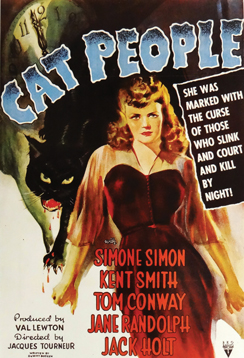Curses, claws and the original cat woman
 CREDIT: RKO, 1942
CREDIT: RKO, 1942Simone Simon stars as the feline femme fatale in 1942's landmark horror film, Cat People.
A woman walks down a street darkened by the cover of night. Her gait is confident at first, but she can’t help suspect that she may not be alone. Casting a glance behind her, she finds nobody is actually there. Her pace quickens, and suddenly, we hear disembodied footsteps quicken in turn. Afraid now, the woman breaks into a run, and the mysterious footfall lands in booming resonance. Who is following her, and more importantly, what are they planning to do once they catch up?
Although this scene has been played over and over in many modern horror movies, it never gets any less unnerving. For audiences who had never experienced anything like it until the release of Cat People (directed by Jacques Tourneur in 1942), it was outright terrifying. The stalking scene of Cat People remains its most influential moment to date, but it is just one of many elements making the film a landmark in the horror genre.
Simone Simon plays Irena Dubrovna, a young Serbian-born woman working as a fashion designer in Manhattan. Both demure and beautiful, she captivates the attentions of engineer Oliver Reed played by Kent Smith. The couple is soon married, but the virginal Irena is hesitant to consummate the marriage. Her native folklore has made her wary of her sexual urges, which according to legend will transform her into a bloodthirsty cat. Torn between her love for Oliver and her nagging sense of foreboding, Irena must untangle fact from superstition before it is too late.
As surprised as today’s audiences may be to see a 1942 movie revolve around sex, the film unabashedly promotes female sexuality as a horrifying supernatural force. While Oliver’s desires are depicted as the everyday inklings of the average hot-blooded American man, Irena’s exotic preoccupation with her own mysterious compulsions makes her anomalous to the point where she is no longer attractive even to him.
The closer Irena gets to understanding herself and her underlying appetites, the more Oliver wants out of their marriage. This leads Irena’s frustrations to come to a head in a number of chilling stalking scenes. The efficacy of these scenes inevitably sparked the oft-used “Lewton Bus” technique in later horror films, which coerces audiences into feeling high levels of tension only to be broken by a sudden jump-scare, or in Cat People’s case, the startling appearance of a bus.
Cat People is largely ambiguous as to whether Irena’s curse is the result of witchcraft or a psychological coping mechanism for existing in a world that touts feminine sexuality as much as it does punish it. From either angle, the film is a particularly notable entry into the American horror canon considering the timing of the film’s release in the midst of the Second World War when gender roles were just starting to shift at home and in the workforce.
With beautiful casting, costumes and noir photography, Cat People is a stylish, cinematic allusion to how double standards can determine our feelings of inclusion or exclusion in society. From this film, there’s something worthy to be reaped for horror fans, feminists and most of all, cat lovers.















